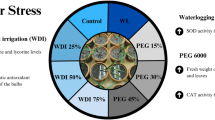Abstract
Data on morphophysiological monitoring of winter wheat (Triticum aestivum L.) cultivar Mironovskaya 808 grown in Hoagland and Arnon solution in a greenhouse and transferred to natural conditions in March–April 2004 with the mean daily temperature of 0.6 ± 0.7°C within the exposure period of 42 days are presented. Water content, dry weight of plants and their organs, frost hardiness of plants, degree of tissue damage by frost, CO2 metabolism (photosynthesis and respiration), concentrations of sugars in tissues and proportions between different sugar forms, and activities of soluble and insoluble acid and alkaline phosphatases were monitored. Monitoring was carried out for three experimental variants simulating different microclimatic conditions in spring: after snow melting (experiment I), under ice crust (experiment II), and under snow cover (experiment III). Plants in experiments III and II demonstrated a higher water content in tissues, lower frost hardiness, higher rates of biomass loss, lower concentration of sugars and lower di-to monosaccharide ratio in tissues, and higher total invertase activity, particularly, cell wall-associated acid invertase activity. The dark respiration rates at 0°C did not significantly differ between experimental variants. The photosynthetic capacity at this measurement temperature was maintained in all experimental variants being most pronounced in experiment II with the most intense photoinhibition under natural conditions. Comparison of experiments III and II with experiment I is used to discuss the negative effect of changes in certain microclimatic indices associated with global warming and leading to plant exhaustion and death from frost in spring.
Similar content being viewed by others
References
Beerling, D.J., Terry, A.C., Mitchell, P.L., et al., Time to Chill: Effects of Simulated Global Change on Leaf Ice Nucleation Temperatures of Subarctic Vegetation, Am. J. Botany, 2001, vol. 88, pp. 628–633.
Belanger, G., Rochette, P., Bootsma, A., et al., Will Agricultural Perennial Plants Survive Climate Change?, Pap. Meet. Palace Roy. Hotel “Plant and Microbe Adaptations to Cold,” May 25–29. Quebec City, 2003, p. 35.
Crawford, R.M.M., The Consequences of Climatic Warming for Northern Crop Production, in New Biological Approaches To Understand and Improve Winter Survival of Plants, Sem. no. 259, Nord. Ass. Agr. Sci. NJF. Arhus (Denmark), 1996.
Hanninen, H., Lundell, R., and Sardine, T., Boreal Trees under Climatic Warming: Is There an Increased Risk of Frost Damage?, Pap. Meet. Palase Roy. Hotel “Plant and Microbe Adaptations to Cold,” May 25–29. Quebec City, 2003, p. 47.
Houghton, J.T., Ding, J., Griggs, D.J., et al., Climate Change 2001: The Scientific Basis, in Contribution of Working Group 1 in the Third Assessment Report of Intergovernmental Panel on Climate Change, Cambridge: Univ. Press, 2001.
Katz, R.W. and Brown, B.G., Extreme Events in a Chilling Climate: Variability Is More Important Than Averages, Clim. Change, 1992, vol. 21, pp. 289–302.
Kirichenko, E.B., Kudre, A., Veisseir, F., et al., Effect of Low Temperature on CO2 Metabolism in Cereals, Dokl. Akad. Nauk SSSR, 1991, vol. 317, no. 1, pp. 246–250.
Klimov, S.V., Pathways of Plant Adaptation to Low Temperatures, Uspekhi Sovrem. Biologii, 2001, vol. 121, no. 1, pp. 3–22.
Klimov, S.V., Cold Hardening of Plants is a Result of Maintenance of an Increased Photosynthesis/Respiration Ratio at Low Temperatures, Izv. Akad. Nauk, Ser. Biol., 2003, no. 1, pp. 57–62.
Klimov, S.V., Astakhova, N.V., and Trunova, T.I., changes in Photosynthesis, Dark Respiration Rates and Photosynthetic Carbon Partitioning in Winter Rye and Wheat Seedlings during Cold Hardening, J. Plant Physiol., 1999, vol. 155, no. 6, pp. 734–739.
Klimov, S.V., Popov, V.N., and Trunova, T.I., Cold Hardiness of Different Tomato and Cucumber Organs in Relation to Photosynthesis, Fiziol. Rastenii, 2000, vol. 47, no. 4, pp. 501–506.
Klimov, S.V., Dubinina, I.M., Burakhanova, E.A., et al., CO2 Exchange as Related to Sugar Accumulation and Invertase Activity during Winter Wheat Cold Hardening, Dokl. Akad. Nauk, 2004, vol. 398, no. 1, pp. 135–138.
Kolupaev, Yu.E. and Trunova, T.I., Invertase Activity and Carbohydrate Content in the Coleoptile of Wheat Exposed to Hypothermic and Salt Stress, Fiziol. Rastenii, 1994, vol. 41, no. 4, pp. 552–557.
Lundell, R., Saarinen, T., and Hanninen, H., Climatic Warming in the North—Effects of Winter-Warm Periods on Field Layer Plants in the Boreal Zone, Pap. Meet. Palace Roy. Hotel “Plant and Microbe Adaptations to Cold,” May 25–29. Quebec City, 2003, p. 53.
Maxwell, B., Arctic Climate: Potential for Change under Global Warming, in Arctic Ecosystems in a Changing Climate: An Ecophysiological Perspective, Chapin, F.S., Jefferies, R.L., and Reynolds, J.F., Eds., San Diego: Academic, 1992, pp. 11–34.
Oberhuber, W. and Bauer, H., Photoinhibition of Photosynthesis under Natural Conditions in Ivy (Hedera helix L.) Growing in an Understory of Deciduous Trees, Planta, 1991, vol. 185, pp. 545–553.
Otsenki ekologicheskikh i sotsial’no-ekonomicheskikh posledstvii izmeneniya klimata (Evaluation of Ecological, Social, and Economical Consequences of Climate Changes), St. Petersburg: Gidrometeoizdat, 1992, p. 250.
Pocock, T.H., Hurry, V., Savitch, L.V., and Huner, N.P., Susceptibility to Low-Temperature Photoinhibition and the Acquisition of Freezing Tolerance in Winter and Spring Wheat. The Role of Growth Temperature and Irradiance, Physiol. Plant., 2001, vol. 113, no. 4, pp. 499–506.
Sturm, A., Invertases. Primary Structures, Functions and Roles in Plant Development and Sucrose Partitioning, Plant Physiol., 1999, vol. 121, pp. 1–7.
Udovenko, G.V., Ustoichivost’ rastenii k abioticheskim stressam, in Fiziologicheskie osnovy selektsii rastenii. T. 2. Ch. 2 (Physiological Basis of Plant Selection. Vol. 2. Part 2), St. Petersburg: Izd-vo Vseros. in-ta rastenievodstva, 1995, pp. 293–352.
Woodward, F.I. and Lomas, M.R., Vegetation Dynamics—Simulating Response to Climatic Change, Biol. Rev. Camb. Philos. Soc., 2004, vol. 79, no. 3, pp. 643–670.
Author information
Authors and Affiliations
Additional information
Original Russian Text © S.V. Klimov, E.A. Burakhanova, I.M. Dubinina, G.P. Alieva, E.B. Sal’nikova, T.I. Trunova, 2006, published in Izvestiya Akademii Nauk, Seriya Biologicheskaya, 2006, No. 4, pp. 448–456.
Rights and permissions
About this article
Cite this article
Klimov, S.V., Burakhanova, E.A., Dubinina, I.M. et al. Morphophysiological monitoring of winter wheat in spring in the context of global climate warming. Biol Bull Russ Acad Sci 33, 363–369 (2006). https://doi.org/10.1134/S1062359006040078
Received:
Issue Date:
DOI: https://doi.org/10.1134/S1062359006040078




